Jonathan Bujak and Alexandra Bujak* reveal how a unique plant changed our planet’s climate - and may do so again...
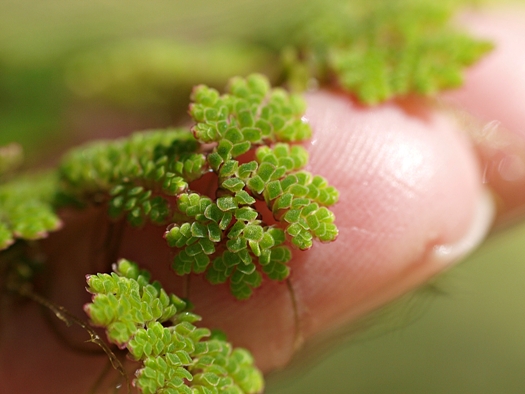 The Cenozoic was characterised by enormous changes in the Earth’s climate that affected the entire biosphere, including the evolution of our own species. These changes resulted from a combination of factors that progressively sequestered the greenhouse gas carbon dioxide from the atmosphere, resulting in cooler global temperatures, particularly at the poles with their year-round cover of ice and snow.
The Cenozoic was characterised by enormous changes in the Earth’s climate that affected the entire biosphere, including the evolution of our own species. These changes resulted from a combination of factors that progressively sequestered the greenhouse gas carbon dioxide from the atmosphere, resulting in cooler global temperatures, particularly at the poles with their year-round cover of ice and snow.
Picture - Azolla, from North America
Our modern bipolar icehouse world contrasts strongly with the earlier greenhouse climate of the Mesozoic, which had lower latitudinal thermal gradients and poles that were much warmer than those of today. The Cenozoic greenhouse-to-icehouse shift is even more striking because the geological record indicates that our present climate, with its bipolar glaciation and succession of glacial-interglacial cycles, is highly unusual and possibly unique in the Earth’s history.
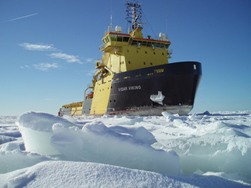 Image: The ACEX scientific drillship, Vidar Viking.
Image: The ACEX scientific drillship, Vidar Viking.
The asteroid impact at Chicxulub on the Yucatán coast, which marked the end of the Mesozoic 66 million years ago, combined with other factors may have had a devastating effect on marine and terrestrial biotas, but it did not affect long-term climate. The early part of the Cenozoic therefore inherited the Mesozoic greenhouse world, which continued through the Paleocene. Extensive volcanism associated with the Greenland mantle plume injected enormous quantities of gases, including carbon dioxide, into the atmosphere, raising temperatures and triggering the release of methane clathrates. This potent combination resulted in high levels of greenhouse gases 55 million years ago during the Paleocene-Eocene Thermal Maximum (PETM, aka. the Early Eocene Thermal Maximum, EETM).
TRIGGER
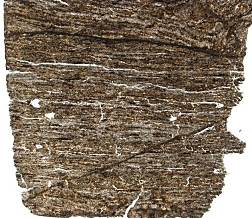
Although temperatures fell after EETM, they remained high during the early Eocene and averaged 12oC to 15oC in the Arctic, where the remains of lush forests are preserved in sediments on Ellesmere Island. It is therefore surprising that initiation of the greenhouse to icehouse shift occurred at the end of the early Eocene which, apart from the EETM, experienced the highest temperatures of the Cenozoic. What could have triggered this remarkable climatic change which eventually led to our present bipolar icehouse world?
Image: Part of the ACEX core dominated by thin brown beds of Azolla.
The answer came in 2004, when reduced ice conditions allowed the scientific drillship, Vidar Viking (above), supported by the Swedish and Russian icebreakers Oden and Sovetskyi Soyuz, to undertake a unique voyage to the North Pole. This was Leg 302 of the Integrated Ocean Drilling Project (IODP), also known as the Arctic Coring Expedition (ACEX). Over the past five decades, IODP and its predecessor, the Deep Sea Drilling Project (DSDP), had systematically drilled sediments beneath the world’s oceans, but extensive ice cover had prevented an expedition to the Arctic Ocean. The expedition’s objective was to core Upper Cretaceous and Cenozoic sediments of the Lomonosov Ridge, which extends for 1800km across the Arctic Ocean and rises three and a half kilometres above the surrounding seafloor. Would the expedition accomplish its mission to core more than 300 metres, while maintaining its drilling location in constantly moving sea ice?
LOMONOSOV
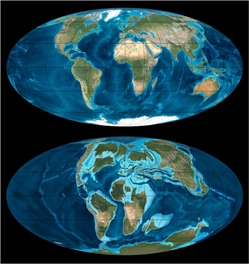 Image: The greenhouse world at the end of the Cretaceous 66 million years ago compared to the modern icehouse world with its bipolar glaciation. Reconstructions courtesy of Dr Ron Blakey, Professor Emeritus NAU Geology, http://jan.ucc.nau.edu/rcb7/mollglobe.html.
Image: The greenhouse world at the end of the Cretaceous 66 million years ago compared to the modern icehouse world with its bipolar glaciation. Reconstructions courtesy of Dr Ron Blakey, Professor Emeritus NAU Geology, http://jan.ucc.nau.edu/rcb7/mollglobe.html.
Vidar Viking reached its drilling location on August 13, but was forced to move to a nearby site due to deteriorating ice conditions. Drilling began on August 18 in 1209 metres of water, but soon encountered more problems, this time due to a shattered core liner, forcing Vidar Viking to move to a third location on August 27. This time it was successful and cored into the Lomonosov Ridge as the two ice-breakers protected it from the drifting sea ice. Finally, on September 8, ACEX recovered cores from sediments deposited during the initial greenhouse to icehouse shift, revealing thousands of organic-rich layers filled with beautifully preserved remains of the floating freshwater fern Azolla. Later analyses confirmed that the ‘Arctic Azolla Event’ lasted for about a million years, beginning in the latest Early Eocene (Ypresian) and ending just after the onset of the Middle Eocene (Lutetian).
Azolla is a floating freshwater fern that can only tolerate slight amounts of salinity. What were millions upon millions of Azolla plants doing in the middle of the Arctic Ocean, and why were they there precisely when the Earth experienced one of the most dramatic climatic changes in its history? Was there a connection between the two events?
 Image: ACEX coring locations close to the North Pole.
Image: ACEX coring locations close to the North Pole.
Following ACEX, a model answering these questions was proposed and repeatedly tested during the next decade when scientists from all over the world analyzed the ACEX cores, confirming its validity and refining its details. It was subsequently published in a series of papers, and featured in the New York Times on 30 November 2004 (‘Under all that ice, maybe oil’), National Geographic in May 2005 (‘Was the icy Arctic once a warm soup of life?’) and Nature in June 2006 (‘From greenhouse to icehouse in 55 million years’).
TURGAY
Following the EETM, the Arctic Ocean was largely land-locked and centered on the North Pole, as it is today, so that it experienced Arctic summers with 24 hours of daylight and winters with 24 hours of darkness, but with much warmer temperatures than those seen today. Its only significant marine connection was through a long narrow seaway called the Turgay Strait, which extended southwards across western Siberia to the equatorial Tethyan Ocean.
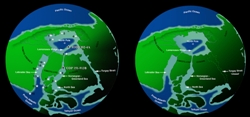 Image: Eocene palaeogeography of the Arctic Ocean before (Turgay Strait open) and during (Turgay Strait closed) the Azolla event.
Image: Eocene palaeogeography of the Arctic Ocean before (Turgay Strait open) and during (Turgay Strait closed) the Azolla event.
Then, 49 million years ago, the shallow Turgay Strait became blocked, and the Arctic Ocean became isolated from the other oceans, similar to today’s Black Sea, which only has a single very narrow connection to the Mediterranean through the Bosporus. Like the Black Sea, the Arctic Ocean became ‘stratified’, with little vertical mixing of its water, so that its bottom waters became anoxic and all bottom-dwelling benthic organisms died out. High greenhouse temperatures also caused more energetic weather than today and increased the amount of rainfall. Rivers discharged large volumes of freshwater, resulting in layers of surface freshwater extending out into the ocean. Satellite images show similar freshwater layers spreading out from today’s Amazon River for hundreds of kilometres into the Atlantic Ocean.
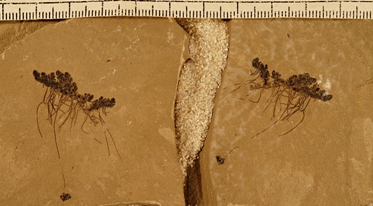 Image: Fossil Azolla dated between 50.5 and 55.5 Ma (million years) from the Green River Formation of Garfield County, Colorado, which are similar in age to Azolla in the ACEX core. The floating leaves and tendrils are identical to those of modern Azolla. Photograph kindly provided by Dr Ian Miller of the Denver Museum of Science.
Image: Fossil Azolla dated between 50.5 and 55.5 Ma (million years) from the Green River Formation of Garfield County, Colorado, which are similar in age to Azolla in the ACEX core. The floating leaves and tendrils are identical to those of modern Azolla. Photograph kindly provided by Dr Ian Miller of the Denver Museum of Science.
This explained Azolla’s presence far from the ancient Arctic Ocean shoreline. In the Arctic spring and summer, the free-floating freshwater plant spread and multiplied on surface freshwater layers that extended from rivers discharging into the ocean. Each bed of Azolla in the ACEX cores represents a single mat or succession of mats of floating Azolla that extended away from shore towards the centre of the Arctic Ocean. As the floating mats became waterlogged or as storms fragmented them, the plants died and sank to the sea floor and lay undisturbed, due to the absence of benthic organisms. The remains of Azolla were then gradually buried by fine sediments or the remains of plankton and other organisms living in the surface water, which formed the thin beds separating the Azolla layers.
This process was repeated again and again, gradually forming the thousands of Azolla beds seen in ACEX cores. Some of them may have been deposited annually, some every few years or longer, others in clusters that were related to climatic cycles that affected temperature and the amount of rainfall and runoff. These details would be gradually teased from the core samples, and many still wait to be refined as increasingly sophisticated techniques become available. However, the general model has stood the test of time.
 Image: Henk Brinkhuis at the North Pole
Image: Henk Brinkhuis at the North Pole
The Arctic Azolla Event lasted for about a million years and scientists are still unsure why it ended. Perhaps the Turgay Strait re-opened and the Arctic Ocean resumed its earlier configuration, or maybe the nutrients needed for Azolla’s growth were finally depleted – nutrients such as phosphates that were supplied by rocks exposed on the land surrounding the Arctic, rocks that may have eventually been eroded away, ending the Azolla Event.
IMPACT
Calculations of Azolla’s volume during the event show that it had a huge impact on the world’s climate. The billions of tiny plants drew down the carbon dioxide needed for their growth directly from the atmosphere, reducing greenhouse gases, and ending the greenhouse climate that had prevailed for hundreds of millions of years. Levels of atmospheric carbon dioxide that had been as high as 2500 to 3500ppm before the Azolla Event were reduced by up to a half by the Azolla Event.
Atmospheric carbon dioxide continued to fall over the next 49 million years due to mountain uplift and changing oceanic currents that sequestered even more carbon dioxide. As atmospheric carbon dioxide fell below 1000ppm about 40 million years ago, permanent ice and snow increased in Antarctica. Then, as it fell even lower to 600ppm just 2.6 million years ago, widespread glaciation began in the Arctic, initiating the succession of glacial-interglacial cycles that characterise today’s icehouse world. Present values are just above 400ppm, having risen from pre-industrial values in the mid 18th Century of about 280ppm.
The atmospheric carbon dioxide sequestered by Azolla was incorporated into the plant biomass, which is preserved in sediments beneath the Arctic, but a crucial question still needed answering. Nitrogen is essential for the growth of all plants and almost all of them obtain this nutrient from nitrogen-based compounds present in the soil or underwater substrate. How was Azolla able to grow so rapidly, free-floating in the middle of an ocean without this source of nitrogen?
 Image: Azolla fertilizing a rice paddy in Ecuador
Image: Azolla fertilizing a rice paddy in Ecuador
Nine months after ACEX, Henk Brinkhuis, the expedition’s palynologist, arranged the first meeting of the ‘Darwin Azolla Group’ at Utrecht University in the Netherlands for geologists with expertise relevant to the Azolla Event. Also invited was biologist Francisco Carrapiço, Assistant Professor at the University of Lisbon’s Department of Plant Biology, and the world’s leading expert on modern Azolla. He was to provide information that would answer the question.
SUPERORGANISM
Azolla is a fern that floats freely on the surface of quiescent freshwater bodies, such as ponds, lakes and gently flowing rivers, and it is one of the fastest growing plants on the planet, doubling its biomass in as little as two days. We know that Azolla is a fern because of its internal structure and the way that it reproduces, but it looks nothing like a fern. Its leaves are composed of small spongy lobes, just a few millimetres long, which float on the water with hair-like tendrils dangling in the water below. Its larger dorsal leaves are buoyant and contain cavities enclosing a symbiotic cyanobacterium called Anabaena azollae.
 Image: Azolla usually floats freely on the surface of freshwater, but tendrils that dangle freely beneath the plant can also root in wet muddy substrate to provide additional nitrogen fertilizer for the plant.
Image: Azolla usually floats freely on the surface of freshwater, but tendrils that dangle freely beneath the plant can also root in wet muddy substrate to provide additional nitrogen fertilizer for the plant.
Although a few other plants have cyanobacterial symbionts, the relationship is lost when the plant dies and has to be renewed each generation. Azolla is unique because it is the only known plant in which a cyanobacterial symbiont is passed to successive generations during the plant’s reproduction. The fossil record indicates that the relationship between Azolla and A. azollae was established in the mid Cretaceous, so that the two organisms have been co-evolving for about 100 million years. This has resulted in their developing highly efficient and complementary biochemistry, enabling Azolla’s phenomenal growth rate.
It is a perfect marriage: Azolla provides a home for A. azollae, which sequesters nitrogen fertilizer for Azolla directly from the atmosphere. Their relationship is now so intimate that many of A. azollae’s genes have been lost or transferred to the nucleus in Azolla’s cells, so that A. azollae can no longer survive independently outside Azolla. All of the genetic evidence indicates that A. azollae is evolving towards a nitrogen-fixing organelle in Azolla, and in 2010 Francisco Carrapiço published his landmark paper: ‘Azolla as a Superorganism’, proposing that Azolla and A. azollae are so closely interconnected that they represent a single superorganism. This was the missing part of the puzzle needed to explain the Arctic Azolla Event. It showed how Azolla was able to repeatedly spread across freshwater surface layers in the Arctic Ocean, sequestering large quantities of atmospheric carbon dioxide, to trigger the initial change from a greenhouse to icehouse climate.
PERFECT STORM
We humans are threatened by a perfect storm as our population passes seven billion thanks to shortages of land, food and energy. Increased emissions of greenhouse gases are also reversing climatic changes that occurred over millions of years. The greenhouse-to-icehouse shift was caused by a succession of processes that took 49 million years, but mankind’s emission of greenhouse gases could reverse this process in just a few decades, changing the climate back to a greenhouse world with dizzying speed. Could Azolla help us combat man-made climate change and also provide local renewable food, livestock feed, biofertilizer and biofuel?
 Image: Bread made from Azolla by Erik Sjodin.
Image: Bread made from Azolla by Erik Sjodin.
Azolla has been used for thousands of years in India and the Far East as a biofertilizer and livestock feed, and its potential as a biofuel is indicated by (unpublished) studies on modern Azolla. It has also been taken on space missions to confirm its use as a food, water purifier and oxygen provider for space travel because of its ability to rapidly grow in stacked trays of shallow water less than three centimetres deep. Azolla can therefore help us tackle the threat of man-made climate change and shortages of land, food and energy. Its potential can be increased because the water in which Azolla grows is enriched in nitrogen sequestered by A. azollae from the atmosphere.
For example, Azolla’s growth can be integrated with the production of algal oil (‘algoil’), with the nitrogen-enriched water from Azolla fertilizing algal growth and increasing the sequestration of carbon dioxide to produce a range of biofuels precisely where they are needed. Or, to take another example, the nitrogen-enriched water used to grow Azolla is an ideal biofertiliser for hydroponics to grow fruit and vegetables, providing local renewable food. And because Azolla can be grown indoors, anywhere in the world under carefully controlled conditions, it has the potential to provide these products globally, promoting urban agriculture in our growing cities and megacities, and helping to provide a permanent solution to regions with repeated famines such as East Africa.
GLOBAL POTENTIAL
This flexibility is the key to Azolla’s global potential. The complex biotechnology has already been developed by Azolla and A. azollae’s co-evolution, so all we need to do is work with nature instead of destroying it. And because Azolla’s biosystem addresses the problems of energy and food as well as climate change, it is not necessary to prioritise them. This resolves the main problem that plagued the 2009 and 2013 Copenhagen and Doha Summits on Climate Change when many developing countries argued that their priority was to feed their people, rather than dealing with problems of climate change. The billions of pledged ‘climate change dollars’ can therefore help developing countries using Azolla’s synergy, thus turning Perfect Storm into Perfect Opportunity.
Geologists are fortunate in having a unique perspective grounded in deep-time. We have traditionally used the present as a key to the past, but we can also use the past to understand the present and shape the future in a positive way. Perhaps the remarkable events that occurred 49 million years ago in the Arctic can help us do that.
 Authors
Authors
* Dr Jonathan Bujak is a palaeontologist who has spent the past 40 years studying Arctic palaeoclimate and the greenhouse to icehouse shift.
 His daughter, Alexandra, is an environmental scientist specializing in modern Azolla’s multiple uses.
His daughter, Alexandra, is an environmental scientist specializing in modern Azolla’s multiple uses.